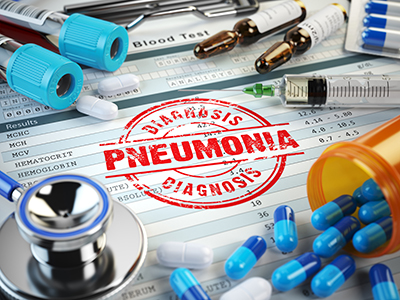Urinary Antigen Testing
Urinary Antigen Testing in Suspected Pneumonia
Clinical Background
 Pneumonia is a common illness affecting approximately 450 million people a year and occurring in all parts of the world. It is a major cause of death among all age groups, resulting in 4 million deaths annually – 7% of total world annual deaths.1
Pneumonia is a common illness affecting approximately 450 million people a year and occurring in all parts of the world. It is a major cause of death among all age groups, resulting in 4 million deaths annually – 7% of total world annual deaths.1
- In the UK the annual incidence of pneumonia is approximately 6 cases per 1000 people in the age group 18-39 years
- This rises to 75 cases per 1000 people in the age group over 75 years
- Roughly 20-40% of individuals contracting pneumonia will require hospital admission
- 5-10% of these are admitted to a critical care unit
- The case fatality rate in the UK is 5-10%.2
Pneumonia is due to infection caused primarily by bacteria or viruses. Although more than 100 strains of infectious agents have been identified as causative pathogens, only a few are responsible for the majority of cases. Bacteria are the most common cause of community-acquired pneumonia (CAP), with Streptococcus
Other commonly isolated bacteria include:
- Haemophilus
influenzae (20%) - Chlamydophila pneumonia (13%)
- Legionella (3.8%)
- Mycoplasma
pneumoniae (3%).3,4
Streptococcus pneumoniae
S.
A rapid diagnosis is essential as these infections can normally be treated with penicillin which is relatively inexpensive and does not induce antibiotic resistance at the same level as other antibiotics.7
Legionella pneumophila
Legionella infections can occur as sporadic or epidemic; and as community-acquired or nosocomial infections. The bacteria are usually present in water and can survive (although not reproduce) for a long time in moist environments. As it can be resistant to a degree, to the effects of disinfectants, it can survive in both natural and treated water.
The genus Legionella contains 40 species and more than 70 serogroups, of which Legionella
Legionnaires disease is
- Penicillin is not effective against Legionella as it is an intracellular bacterium
- Treatment with antibiotics like macrolides or quinolones that penetrate the infected cells is required
- Diagnostic methods to confirm the presence of Legionella in the initial phase are important for the prognosis of the disease
Diagnostic Methods
The diagnosis of pneumococcal pneumonia is based on the presence of clinical signs of pneumonia, chest radiograph, lung infiltrates and microbiological findings. In the clinical
Culture is still the “gold standard” for the diagnosis of Legionella infection and is generally 100% specific.
Pneumococcal antigen detection dates back to the work done by Dochez and Avery in 191717,18 where they demonstrated capsular polysaccharides in urine from patients with lobar pneumonia. In 1999 the first S.
Serology remains an important tool in the diagnosis of Legionnaires Disease but these days the main method in Europe for diagnosing the disease is the Legionella urinary antigen test.23 Over the past few
The current UK guideline from the British Thoracic Society recommends:
- Pneumococcal urine antigen tests should be performed for all patients with moderate or high severity CAP
- Legionella urine antigen tests should be performed for all patients with high severity CAP
- A rapid testing and reporting service for both tests should be available to all hospitals admitting patients with CAP.24
Publication of the new NICE guideline for Pneumonia: diagnosis and management of community- and hospital-acquired pneumonia in adults is expected in December 2014. The draft copy in consultation suggested that the use of rapid diagnostic tests for urinary antigen detection could improve antibiotic stewardship.25
Testing
The SD Biosensor Standard F system provides a rapid cost effective means of urinary antigen testing. For further information see below:

- Legionella urine antigen detection
- Streptococcus pneumoniae urine antigen detection
- Influenza A/B detection in respiratory samples
- Respiratory syncytial virus (RSV) detection in respiratory samples
- Streptococcus A detection in respiratory samples
- Procalcitonin (PCT) detection in blood samples
- Other kits